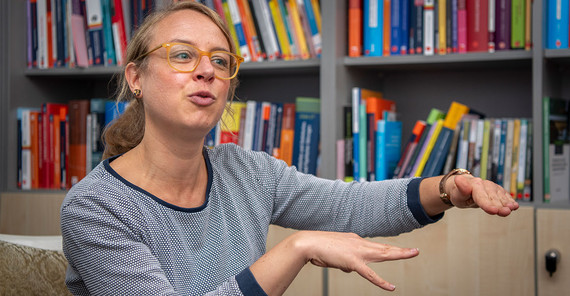“The schools themselves should be perceived as experts and involved in the further development of school education,” says the educational researcher. “So that they not only have to face the challenges but can also influence how to go about them.” At the moment, exactly this is not the case. “We all want to support students and prepare them for their future lives in the best possible way,” Rjosk says. “But not only with regard to the subjects but also beyond so that they can be part of a society that not only delivers but also represents values.” Many would agree with this, she is sure. But the way to get there is controversial.
Integrating school into research
Diversity, digitalization, and heterogeneity – the areas in which a lot is happening and which are vehemently discussed are clearly outlined. It also seems to be clear where the journey should lead to: Teaching needs to become more diverse, more digital, and more heterogeneous. “A lot is currently changing and a lot is being demanded from schools,” she says. “This is extremely difficult to orchestrate - and the schools themselves are not very involved.” Rjosk wants to change this. She intends to establish a network on schools with whom she wants to discuss ideas as well as develop and test concepts.
At the same time, the educational researcher hopes that this will take her research results to the places where they are needed. After all, one of her focuses is “multidimensional heterogeneity in the classroom”. Since 2021, she has been leading a junior research group with the same title, which is funded by the Federal Ministry of Education and Research (BMBF). Together with her team, the educational researcher is investigating how heterogeneity can be measured, what is its impact and, ideally, how it can be used profitably. “I would like to see inclusion and heterogeneity considered more closely together in the future,” Rjosk says. For a long time, inclusion was a kind of synonym for the transfer of special needs education into normal lessons. “But real inclusive teaching must take many more differences into account in order to support students in a better way – both individually and together.” This is where heterogeneity comes in: Social status, family background, gender, language, and aptitude are many facets that influence how children learn. However, these aspects have not been considered in the classroom for a long time. And if so, they tend to be seen as factors that get into the way of successful teaching. Yet heterogeneity in the classroom creates important added value, Prof. Rjosk is convinced. “Good teaching uses diversity as a resource,” she says. “The children should also learn from and support each other.” This ultimately helps them both in terms of school achievement and social development. “It teaches them what real diversity is. That becomes much more difficult later in life because you tend to choose who you surround yourself with.”
Using the added value of heterogeneity
Good inclusive teaching should differentiate and at the same time emphasize similarities, she explains. Ideally, teachers can select from a collection of teaching materials that match the interests, knowledge, and learning styles of the students. It also needs more pair or group work, on projects –- in formats that enable “everyone to contribute their own skills and knowledge”. Of course, this requires solid preparation, guidance, and evaluation.
Prof. Rjosk wants to accompany schools on the path towards this kind of inclusive teaching. To this end, she is developing methods that can be used to record heterogeneity in school classes. “But how can the individual facets be defined? How do they influence each other? And how do they influence learning, motivation, and performance? These are questions that have been on Rjosk’s mind since her doctoral project. For her doctoral thesis, she investigated whether it has an impact on learning who learns with whom in a class. She specifically looked at the three factors of school performance, social background, and migration experience. “I was able to show that the social composition of the school class is more important for development than the proportion of adolescents with a migration background and teaching in classes with different compositions contributes to this ,” she says. She and her research group are now building on this initial analysis of the wide field of heterogeneity. Their aim is to record heterogeneity in schools in future on the basis of several dimensions: Origin, social status, gender, performance, and special educational needs are among the aspects they want to take into account. They are currently applying methods from various disciplines to describe heterogeneity and are developing a theoretical model on the effects of heterogeneity in the classroom. They are also collecting research literature that already exists on individual aspects for so-called meta-analyses. A lot of research has already been done on the influence of ethnic origin on school achievement, for example. The educational researchers take up these findings and merge them to develop instruments that can then be used to conduct research projects on multi-layered heterogeneity. “Ideally, we will already do this together with schools that also contribute how they perceive heterogeneity, how they deal with it and use it – for the benefit of the students,” Rjosk says.
The Researcher
Prof. Dr. Camilla Rjosk has been head of the junior research group “Multidimensional Heterogeneity in the Classroom: Measurement, Effects, Mechanisms (MuHiK)” since 2021 that she brought to Potsdam when she became Professor of School Development at the University of Potsdam at the beginning of 2023.
Email: camilla.rjoskuuni-potsdampde
The Project
Junior Research Group „Multidimensional Heterogeneity in the Classroom: Measurement, Effects, Mechanisms (MuHiK)“
In this five-year project, the researchers investigate how student heterogeneity can be measured based on more than one student characteristic and how heterogeneity is connected with students’ achievements and psychosocial characteristics. The project is funded within the Framework Program for Empirical Educational Research of the Federal Ministry of Education and Research (BMBF).
Link to the project: https://www.uni-potsdam.de/de/schulentwicklung/forschung/muhik
Multidimensional Heterogeneity in the Classroom: Measurement, Effects, Mechanisms MuHiK)
Project description
In April 2023, the interdisciplinary junior research group “Multidimensional Heterogeneity in the Classroom: Measurement, Effects, Mechanisms (MuHiK)“ moved to University of Potsdam. In this five-year project, we investigate how student heterogeneity can be measured based on more than one student characteristic and by considering the entanglement of multiple heterogeneity dimensions. Another aim is to examine relationships between multidimensional heterogeneity and student achievement as well as psychosocial outcomes. The project is funded by the Federal Ministry of Education and Research (BMBF).
Background
How diversity or heterogeneity of the student body affects individual learning is of major interest for educational practice, politics and research. However, existing studies on heterogeneity effects within classrooms show inconsistent findings and most commonly rely on only one dimension of heterogeneity (e.g., achievement or ethnic background). This procedure disregards that heterogeneity in the classroom is (more) complex and multidimensional. Each person is characterized by a combination of characteristics (e.g., gender, multilingualism). Therefore, heterogeneity has to be viewed as multidimensional—even at the classroom level. In the project, we consider this multidimensionality to predict classroom-level processes. For instance, a classroom that is heterogeneous in terms of achievement, gender, and multilingualism might require different instructional behaviors by teachers or lead to different peer formation processes compared to a classroom that is heterogeneous in terms of achievement and gender.
Project content and goals
The work of the junior research group started with reviewing current research on effects of various diversity dimensions on student achievement and psychosocial outcomes (e.g., interests, school-related well-being). Currently, the project strives to advance methodology to measure multidimensional heterogeneity as a construct at the classroom level. This includes transferring economic approaches on team diversity to the analysis of the classroom context. Based on analyses of existing datasets, the project investigates how multidimensional heterogeneity contributes in predicting student achievement and psychosocial outcomes. Furthermore, we analyze how process characteristics at the teacher level (e.g., instructional behavior, stress) as well as at the peer level (e.g., mutual support, classroom climate) can explain heterogeneity effects on student outcomes. The overall goal is to describe how learning can succeed within a multidimensional heterogeneous student body and to identify promising areas for future interventions by involving stakeholders in educational practice.
The research questions of the project address the domains measurement, effects, and mechanisms as follows:
Cooperation with stakeholders in educational practice
The project includes ongoing cooperation with stakeholders in educational practice, especially from the fields of teacher training and teacher development as well as school organization. We will discuss the steps of the project and potential limitations, main project findings as well as their dissemination and utilization in educational practice on a regular basis. Towards the end of the project, a conference that involves educational stakeholders will be held to discuss the project findings and summarize them in a project synthesis related to educational practice.
This text was published in the university magazine Portal Wissen - Eins 2024 „Bildung:digital“ (PDF).


